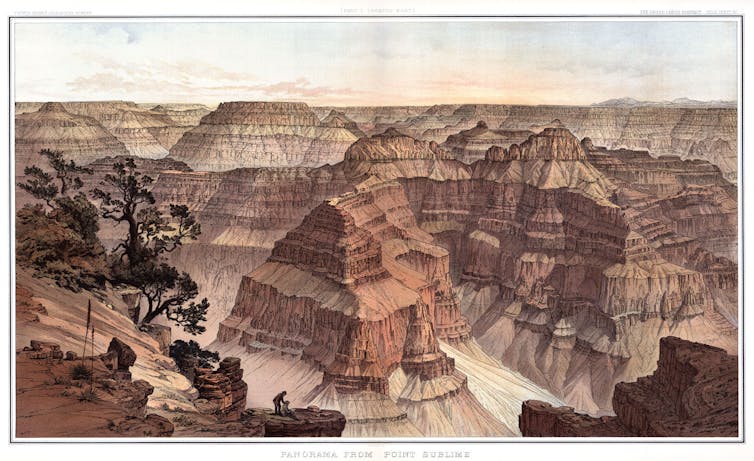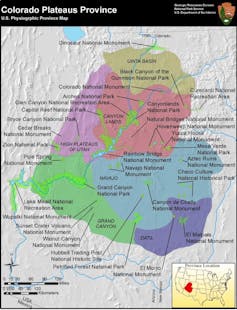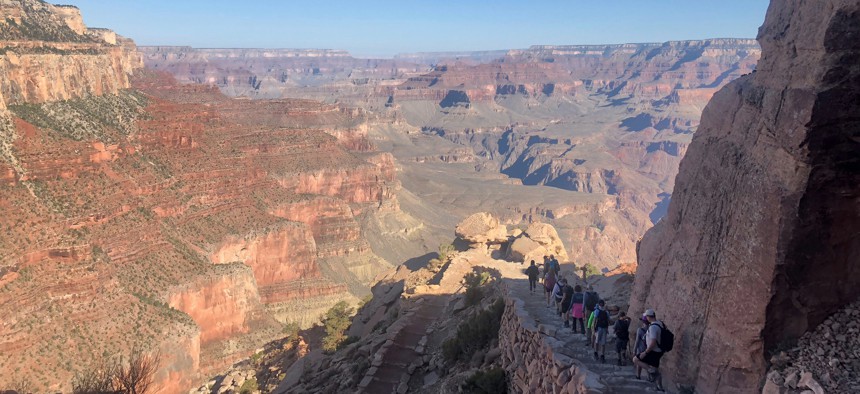Grand Canyon National Park Turns 100: How a Place Once Called ‘Valueless’ Became Grand
The Grand Canyon, which marks 100 years as a national park on Feb. 26, 2019, is known today as an iconic natural wonder. But early European visitors weren't impressed.
Few sights are as instantly recognizable, and few sites speak more fully to American nationalism. Standing on the South Rim in 1903, President Teddy Roosevelt proclaimed it “one of the great sights every American should see.”
It’s true. Every visitor today knows the Grand Canyon as a unique testimony to Earth’s history and an icon of American experience. But visitors may not know why. Probably they don’t know that it was big and annoying long before it was grand and inspiring. Likely, they don’t appreciate that the work of appreciating so strange a scene has been as astonishing as its geological sculpting. Other than a pilgrimage to a sacred site, they may not understand just what they are seeing.
As Grand Canyon National Park celebrates its centennial on Feb. 26, 2019, it’s worth recalling the peculiar way the canyon became grand and what this has meant.
‘This profitless locality’
The Grand Canyon was one of the first North American natural wonders to be discovered by Europeans. In 1541, a party of the Coronado expedition under Captain García López de Cardenas stood on the South Rim, 138 years before explorers found Niagara Falls, 167 before Yellowstone and almost 300 before Yosemite. A group scrambled down to the river but failed to reach it, and returned to announce that the buttes were much taller than the great tower of Seville. Then nothing. Some Coronado chroniclers did not even mention this side trip in their accounts.
A Franciscan friar, Francisco Tomas Garcés, tracing tribes up the Colorado River, then visited the rim in 1776, discovered the Havasupai tribe, and departed. Fur trappers based in Taos knew of the great gorge, which they called the Big Cañon, and shunned it. When they guided exploring parties of the U.S. Army Corps of Topographic Engineers in search of transportation routes, they steered the expeditions away from the canyon, which offered no passage by water or land.
Then in 1857, Lt. Joseph C. Ives led a steamboat up the Colorado River in explicit quest of the Big Cañon. After the steamboat struck a rock and sank near Black Canyon, Ives traveled down Diamond Creek to the inner gorge, briefly touched at the South Rim, and in 1861 concluded with one of the most infamous proclamations to ever emerge from an American explorer.
The region is, of course, altogether valueless … after entering it there is nothing to do but leave. Ours has been the first, and will doubtless be the last, party of whites to visit this profitless locality.
Eight years later Major John Wesley Powell descended the Colorado River through its gorges, renamed the Big Cañon as the Grand Canyon, and wrote a classic account of the view from the river. In 1882 Captain Clarence Dutton, in the first monograph published by the new U.S. Geological Survey, wrote an equally classic account, this time from the rim.
Something had changed. Mostly it was the advent of geology as a science with broad cultural appeal. The Grand Canyon might be valueless as a corridor of transport, but it was a “wonderland” for the new science. It helped enormously that artists were drawn to landscapes, of which the canyon seemed both unique and operatic. Urged by Powell and Dutton, Thomas Moran and William Henry Holmes transformed a supremely visual scene into paint and ink.

Panorama from Point Sublime, illustration of the Grand Canyon by William Henry Holmes, published in Clarence E. Dutton, ‘Tertiary History of the Grand Cañon District’ (1882). USGS
Before Powell and Dutton, the Grand Canyon was a place to avoid. Now it was a marvel to admire. Twenty years later Teddy Roosevelt stepped off a train at the South Rim and added nationalism to the mix by declaring it “a natural wonder … absolutely unparalleled throughout the rest of the world.”
It was an astonishing reversal of perception. The geologic mystery of the canyon is how the south-trending Colorado River made a sudden turn westward to carve its way, cross-grained, through four plateaus. This is also more or less what happened culturally. Intellectuals cut against existing aesthetics to make a place that looked nothing like pastorals or alpine mountains into a compelling spectacle.
Unlike most great features, the Grand Canyon is invisible until you stand on its rim. You aren’t drawn to it as to a river’s source or a mountain’s peak. You have to seek it out, and then cope with its visual revelation. It simply and suddenly is.
So it appeared to Western civilization. As Dutton pointed out, the canyon, “while the sublimest thing on earth,” was “a great innovation in our modern ideas of scenery,” and appreciating a scene so alien to European sensibilities demanded the invention of a new aesthetic. It required its own unique canon of appreciation. The Grand Canyon stood alone.
Humans can only mar it
It still does, which makes its standing as a natural wonder paradoxical. Yet in two ways the canyon has strengthened both the aesthetics of landscape and its preservation.
First, it added an appreciation for exposed rock, gorges and earth colors to the traditional focus on the bucolic, the alpine and the green. It made it possible to value the larger setting of the Colorado Plateau, which contained the Grand Canyon but otherwise lay to the margins of American settlement and economy. This region now has the highest density of parks and monuments of any physiographic province in the country.

Colorado Plateau national parks and monuments. NPS
Second, the Grand Canyon contributed to the rise of postwar environmentalism through debates in the 1960s over proposed dams. The canyon had enough cultural cachet that advocates could argue successfully to protect it. Slightly upriver, Glen Canyon by contrast lacked that heritage and got dammed.
Yet the Grand Canyon sits awkwardly in more contemporary preservationist thinking. The larger thrust has been to expand beyond geologic monumentalism, typical of early parks, and incorporate living landscapes rich in biodiversity and unique habitats. But the Grand Canyon is a geological spectacle. If it contained nothing alive within its immense amphitheater, it would still retain its cultural power. Its scale is so vast that, other than flooding it above the inner gorge, it’s hard to imagine what people might do to permanently alter it.
Yet it is possible to spoil the canyon experience. What it takes is an obscured sky, or a visually confused viewpoint, or social noise that distracts from the quiet calm of individual vision. The Grand Canyon’s great impact still derives from the sudden shock of seeing it all without filters or foreground. The rim just falls away. The canyon is there, instantly and insistently. It is an individual epiphany, unmediated. That sensation is what must survive for the Grand Canyon to work its cultural alchemy.
Threats to it are not new, but they have evolved from mining, dams and industrial tourism to the compounding insults of an Anthropocene era. Still, as Roosevelt understood, the Grand Canyon testifies to that most fundamental of all needs. “Leave it as it is. … The ages have been at work on it, and man can only mar it.” Keep it, he urged, “for your children, your children’s children, and for all who come after you.”
We can do that in spite of climate change, invasive species, a feckless global economy, dysfunctional politics, and a national attention span for which sound bites take too long. We can leave it as it is.
![]()
This post originally appeared at The Conversation. Follow @ConversationUS on Twitter.





